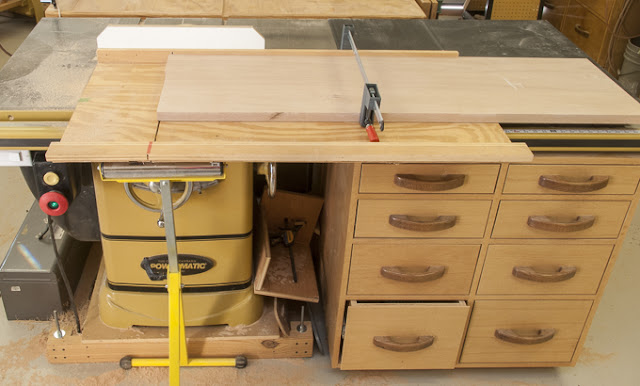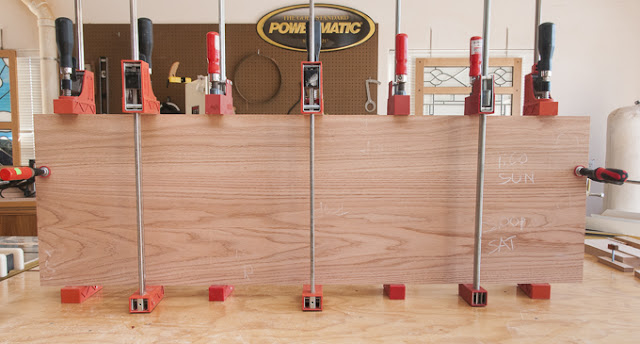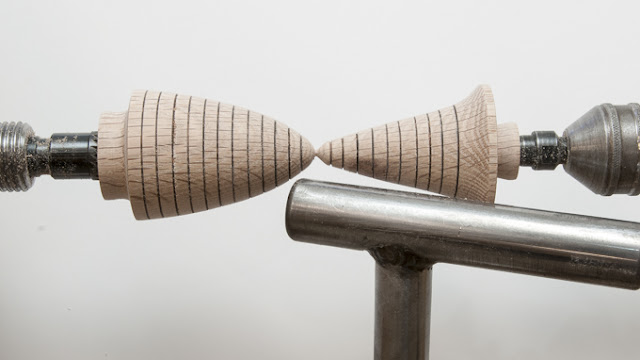I could now start running the pieces through the
thickness sander to clean up any slight misalignments of the joints and
flatten. I can’t use the planer because
it can only do 12 ½” wide pieces and the panel is 16”.
Because I am pushing the maximum size of the sander it creates some problems. First, it is rated for a
16” sanding pass, but that’s nominal.
Effective width is around 15 ½” so it leaves a little ridge on each side
that has to be frequently removed.
Second, because I am at the width limit I can’t shift the
piece from side to side which means the glue joints hit the same exact place on
every pass and builds up on the sandpaper as in the photo below.
 |
| Glue Build-up on Sanding Abrasive |
If very much builds up it causes a nice burn mark the
full length of the piece along the glue joint.
The fix is to frequently stop and scrape the glue residue off the
sandpaper. Unfortunately, that is a fix
with a decreasing return. Each time I do
clean it up the time before I need to do it again is less.
 |
| Temporary Cleanup of Glue |
Third, because of the piece width I can remove only about
1/32” per pass which does not sound like much but in one pass that means it is
converting over 26 cubic inches of red oak into sawdust.
All in all, it took me the better part of two days to
take the 44 square feet of surface area on both sides clean up slight
misalignments of the joints and flatten, then rip to final width. There is still a lot of work to do but this
is what it looks like.
 |
| Flattened Table Leaves Cut to Width but Not Length |
My next step is to cut the four top sections to
length. First choice for cutting a long
heavy piece to length would be my chop saw but that won’t work because it
cannot cut a piece this wide. I do have
a crosscut sled that makes cutting large pieces work pretty well on the table
saw.
 |
| Crosscut Sled on Table Saw |
I started by squaring up one edge then making a second
skim cut.
 |
| First Edge to be Square Cut |
The cut on the other end to finish length is done in a
two-step process. First is to make a cut
about a 32nd of an inch long using a stop block set up on the sled.
 |
| Cutting Leaf Slightly Long |
The second cut is to finished length. I don’t want to move the stop block so use a
spacer 1/32” thick to make that last skim cut.
This way all the pieces will be cut the same length.
 |
| Stop Block with Shim Ready to Make 2nd Skim Cut to Final Length |
I thought about the next steps and decided rather than
continue on with finish sanding, routing the edges of the top then end up
installing the pegs that will align the leaves I would start with the
pegs. Once they are all in place I will
move on to finish sanding and routing the top edges. I plan on taking this route in case there is
some slight misalignment when laying out and installing the pegs that requires
some work on the leaves. No sense in
doing the finish work twice.
Before I actually started drilling holes in the leaves
for the alignment pegs I did some testing.
I sure don’t want to make any irreparable mistakes on one of them. That would mess up more than my whole
day. Starting with some scraps from the
leaves I laid out three peg locations then using a self-centering doweling jig
drilled 1” deep by 3/8” diameter holes in both pieces.
Next came the pegs.
I had some 3/8” fluted dowels that I thought might work out. Some five tries later I had developed a shape
I was happy with. I was not happy in how
they looked or the material hardness so decided to try a different wood. Since the table is out of red oak and I have
a lot of scraps to work with I tried that.
It worked out better but oak is an opened grained wood and after turning
it on the lathe I decided I wanted a close grain wood. Both maple and cherry came to mind but
because the maple is soft maple I opted to go with cherry.
 |
| Peg Tests |
Last test is using the final peg design install them in
the leaf scraps and check to see how they come together. Here is a pair of photos, the top one has
the pegs installed in one piece. The
other has the holes that will go on the pegs.
The bottom photo shows what the two leaves when almost pushed
together. Sizing the tapered end of the
pegs is like Goldilocks and the three bears.
You want the pegs to fit just right.
Too loose and the leaf will be free to move around and not be
aligned. Too tight and while it will
align it will take a gorilla to put leaf in place or remove it. It’s a balance that is measured in a few
thousand’s of an inch. Throw in the
humidity change between New Mexico and Arkansas and it becomes even more interesting. Actually I am going to leave them unfinished and removable so if needed they can be easily modified.
 |
| Testing the Pegs and Alignment Process |
With the testing done I started on making the 18 pegs
needed. They start with a cherry blank
7/16” square. That gets inserted through
the 4-jaw chuck on the lathe. The green
tape on the tool rest has my reference measurements laid out on it. Since so many pegs need to be made this will
help speed things up by not having to measure each one.
 |
| Square Peg Blank Ready to Turn |
The square blank is turned round and to a rough
size. Here I am using a 3/8” wrench to
check the size of the turning. It works
really well; I don’t even have to turn the lathe off to check the size. When it just slips over like this I quit
turning. The wrench may say 3/8” but it
is .007” over.
 |
| Using Wrench to Check Peg Diameter |
I transfer the measurements from the green tape by eye
then turn the tapered end.
 |
| Peg Ready to be Parted Off |
The rough peg is cut off and driven through a die exactly
3/8” in diameter. This is where the 3/8”
wrench being slightly oversize is a good thing.
As much as I try it’s really hard to hit an exact size so being a smidge
over gives me a little leeway.
 |
| Die for Sizing Peg |
The peg is then put back in the lathe for sanding which
removes just enough material for a snug fit into the drilled 3/8” holes. Three pegs down and 15 to go plus a couple
extras. Turning the cone shaped end of the
pegs for a final fit will come after I drill the holes in the leaves and do
finishing alignment.
Next Up – Drilling Peg Holes & Routing Top Edges












































